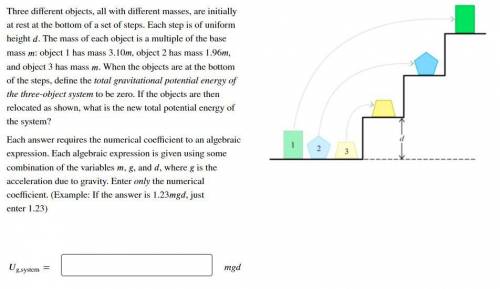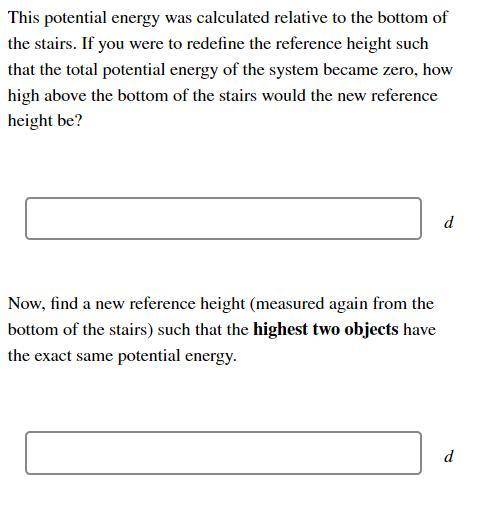
Physics, 04.02.2022 01:00 olivernolasco23
Three different objects, all with different masses, are initially at rest at the bottom of a set of steps. Each step is of uniform height . The mass of each object is a multiple of the base mass : object 1 has mass 3.10 , object 2 has mass 1.96 , and object 3 has mass . When the objects are at the bottom of the steps, define the total gravitational potential energy of the three-object system to be zero. If the objects are then relocated as shown, what is the new total potential energy of the system?
Each answer requires the numerical coefficient to an algebraic expression. Each algebraic expression is given using some combination of the variables , , and , where is the acceleration due to gravity. Enter only the numerical coefficient. (Example: If the answer is 1.23 , just enter 1.23)
This potential energy was calculated relative to the bottom of the stairs. If you were to redefine the reference height such that the total potential energy of the system became zero, how high above the bottom of the stairs would the new reference height be?
Now, find a new reference height (measured again from the bottom of the stairs) such that the highest two objects have the exact same potential energy.



Answers: 3
Another question on Physics

Physics, 22.06.2019 10:00
Two objects of different mass start from rest, are pulled by the same magnitude net force, and are moved through the same distance. the work done on object 1 is 900 j. after the force has pulled each object, object 1 moves twice as fast as object 2. how much work is done on object 2?
Answers: 1

Physics, 22.06.2019 10:00
What is the temperature in degrees celsius of a substance with a tempature of 49k
Answers: 2

Physics, 22.06.2019 11:20
If a rock is thrown upward on the planet mars with a velocity of 12 m/s, its height (in meters) after t seconds is given by h = 12t − 1.86t2. (a) find the velocity of the rock after two seconds. m/s (b) find the velocity of the rock when t = a. 12−3.72a m/s (c) when will the rock hit the surface? (round your answer to one decimal place.) t = s (d) with what velocity will the rock hit the surface? m/s
Answers: 1

Physics, 22.06.2019 12:30
What would be the strength of earth's gravitational field at a point where an 80.0 kg astronaut would experience a 80% reduction in weight
Answers: 3
You know the right answer?
Three different objects, all with different masses, are initially at rest at the bottom of a set of...
Questions

Mathematics, 22.09.2020 21:01



Geography, 22.09.2020 21:01


Biology, 22.09.2020 21:01





English, 22.09.2020 21:01

Computers and Technology, 22.09.2020 21:01

Computers and Technology, 22.09.2020 21:01





Mathematics, 22.09.2020 22:01




